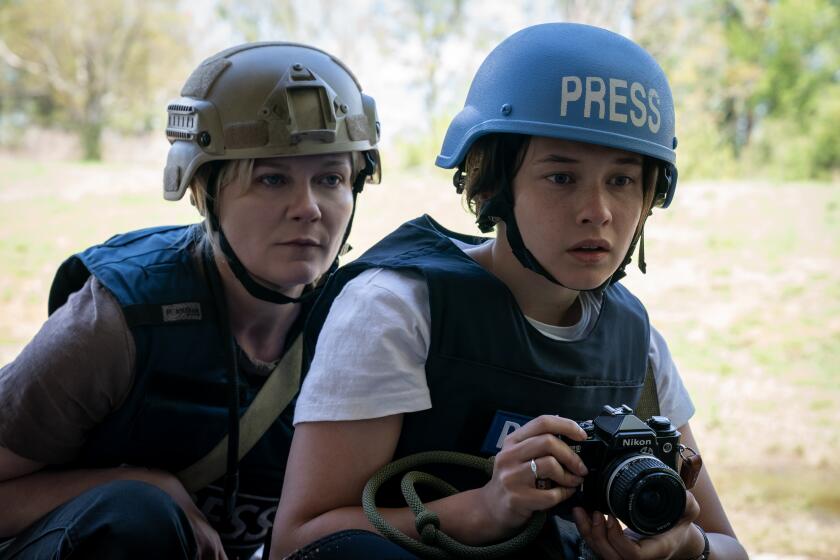Bringing a raft of experience to ‘Life of Pi’
NEW YORK — Ang Lee, the famously meticulous director of “Life of Pi,” originally had planned to hire a survival consultant to infuse the allegorical tale of a boy’s oceangoing raft journey with a tiger with a dose of realism.
Then he read Steven Callahan’s riveting 1986 memoir, “Adrift,” detailing his own perilous life-raft adventure in the Atlantic. In Callahan, Ang and screenwriter David Magee saw a guide who understood and could articulate the metaphysical themes they were hoping to explore in the film.
“We very quickly realized we were dealing with someone who had more than just passing knowledge in the kind of story we were trying to tell,” Magee says.
In January 1982, Callahan – “30 and full of beans” — set sail from Finisterre, Spain, on a solo trek across the Atlantic. Little more than a week into the journey, his 21-foot sloop Napoleon Solo sank in a lonely stretch of the Atlantic some 450 miles west of the Canary Islands. Callahan spent the ensuing 76 days living as an “aquatic caveman” aboard a 6-foot raft he named Rubber Ducky.
Food was scarce initially, but as Rubber Ducky drifted along the North Equatorial Current toward the Caribbean, barnacles began to collect on the bottom, attracting small fish and, eventually, an entire school of dorado (mahi mahi).
“At first the ocean is crystal clear and empty, and it’s like, how am I going to possibly live out here? But after a few days, anything that floats in the ocean develops an island ecology,” Callahan said in a phone interview from his home in Maine, where he is battling leukemia. “Life is profound in that way.”
Like Pi and his tiger, Callahan grew unexpectedly attached to his “little doggies,” able to recognize an individual fish nudging against the raft “the way you recognize different neighbors’ knocks on the back door,” he wrote in “Adrift.”
Nevertheless, he killed one every few days for sustenance, and the fish sometimes fought back. The darkest moment of his journey arrived on Day 43, when a flailing dorado punctured a 4-inch hole in the raft. It took Callahan 10 days of desperate trial and error to finally jury-rig a patch using a fork and some fishing line.
The constant struggle for survival was like “life on steroids,” says Callahan. “If some little thing comes along and works, it’s like elation. And if something presses you down, it is just the most painful thing.”
When Callahan was finally rescued, just off the coast of the small Caribbean island of Marie-Galante, it was again thanks to the dorado. A group of local fishermen spotted birds on the horizon, circling the school of fish, and came to investigate. What they found — in addition to a jackpot of prized dorado — was a bearded, emaciated man who hadn’t laid eyes on another human in nearly three months.
“The dorado fed me, they nourished me, they almost killed me, and in the end they brought my salvation,” Callahan says. Despite feeling like “a Judas,” Callahan happily waited while the fishermen hauled in the dorado. “This is the greatest gift I could possibly give to these guys. We’re all brothers of the sea.”
After some recuperation, Callahan eventually returned a changed man.
“I had convinced myself I was kind of a sea creature. And I learned from the experience I was definitely not a sea creature and they were all very much superior to me in that domain, and that I very much needed people.”
A brief but intense period of media attention followed, including an appearance on “The Tonight Show” and a profile in People magazine. Callahan returned to the seafaring life, sailing all over the world, lecturing and designing boats – including an improved life raft called “The Clam.”
There are small habits left over from his days aboard Rubber Ducky that he’s never quite been able to shake. For a long time he made sure to have food – a small jar of peanut butter or the like — with him everywhere he went; to this day, he still has to remind himself to stay hydrated. “My natural tendency is to conserve water,” he says.
Otherwise, according to Lee and Magee, there are few outward indications that Callahan endured such a harrowing ordeal.
“I didn’t see a trace of the traumatic; all I see is the courage,” Lee says. “He can make even the most painful experience sound interesting and serene.”
Callahan ended up working with nearly every department on the film during months of production in Taiwan. He coached Suraj Sharma, the young actor playing Pi, about the psychological distress of being adrift, and crafted numerous props, including a shade canopy using only materials Pi would have had on the lifeboat. He also spent countless hours experimenting with the 1.86-million gallon wave tank built especially for the film.
Some of the impressions he shared with Lee made it into the film, such as a jumping phosphorescent whale and the sense that, on a clear, mirror-calm night, being at sea can feel like being in space.
“I’m not very good at sitting around. I get my fingers into everybody else’s pie,” Callahan says.
He’s approaching his fight against leukemia with the same determination and spirit of experimentation that kept him alive all those years ago, becoming just the third patient to undergo a stem-cell transplant in a clinical trial.
Callahan was happy to get the go-ahead from his doctor to see “Life of Pi” in the theater. “I am so grateful that the winds of fate took me to work on it.”
He’s not alone. “I have to think the movie’s special partially because of him,” Lee says. “Or maybe the movie’s special and we attracted him and it’s karma.”
More to Read
Only good movies
Get the Indie Focus newsletter, Mark Olsen's weekly guide to the world of cinema.
You may occasionally receive promotional content from the Los Angeles Times.






